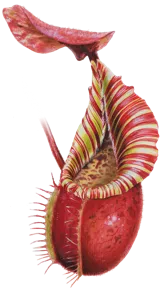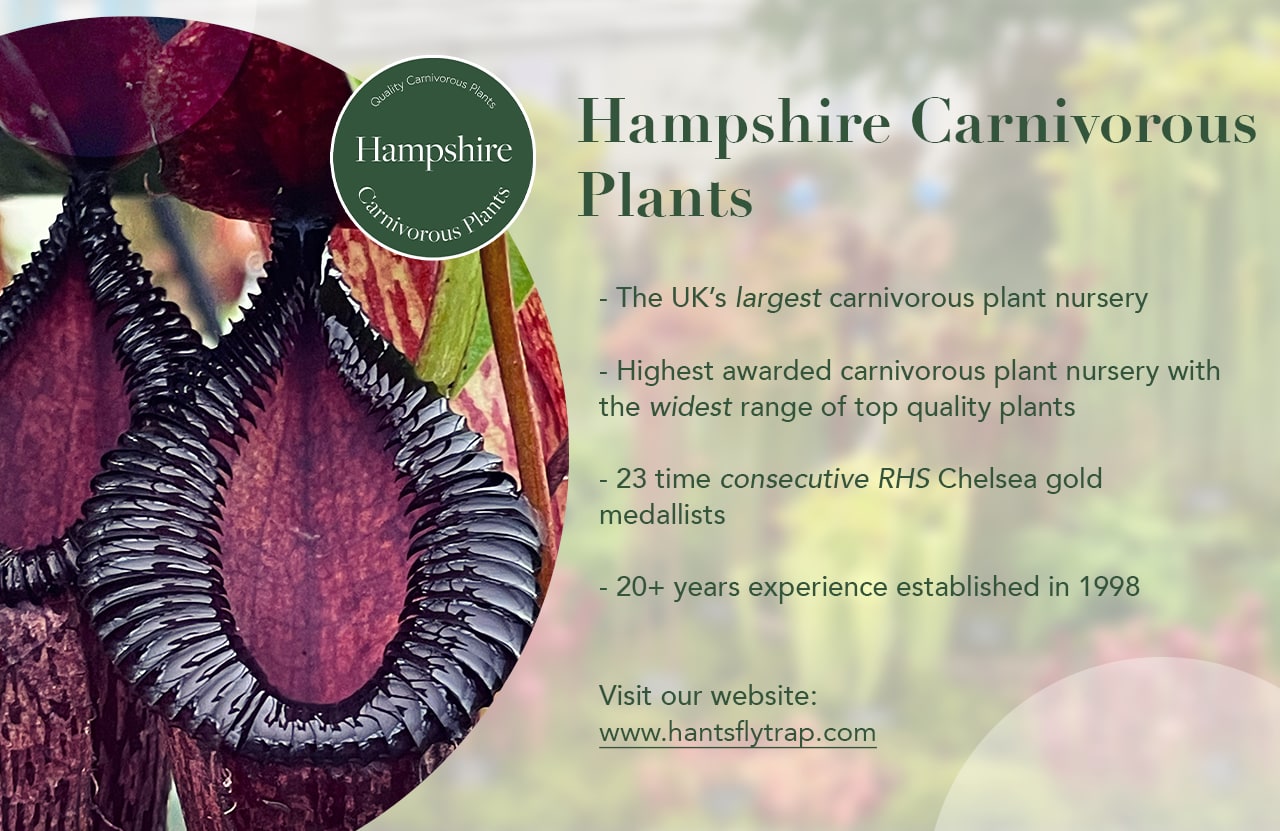As an Amazon Associate, I earn commission from qualifying purchases.
As with all plants, the key to successfully growing Nepenthes in cultivation is the ability to replicate the conditions of their natural habitat.
Most of the 170+ Nepenthes species are found in Southeast Asia - particularly Borneo, Sumatra, and the Philippines - and the genus ranges from highland montane plants to those inhabiting steamy lowland jungles. But their cross-fertile nature has resulted in countless unique hybrids, both in cultivation and in the wild.
This guide aims to help growers of Nepenthes estimate the requirements of specific plants. It comprises two tools: (1) a calculator which visualises the temperatures likely preferred by a given species or hybrid, and (2) an interactive list of every Nepenthes species, which can be sorted and filtered according to altitude and locale.
Happy growing!
1. The Nepenthes Calculator
Enter species (e.g. rajah):
N. x| Elevation (m) | Avg Day Temperature (°C) | Avg Night Temperature (°C) |
|---|---|---|
| 3500 | 16 - 22 | 4 - 12 |
| 3000 | 17 - 23 | 7 - 14 |
| 2500 | 18 - 24 | 9 - 15 |
| 2000 | 20 - 26 | 11 - 17 |
| 1500 | 22 - 28 | 13 - 19 |
| 1000 | 24 - 30 | 15 - 21 |
| 500 | 26 - 32 | 17 - 23 |
| 0 | 29 - 35 | 20 - 26 |
Want to support the development of this tool? 🌱 Click here.
2. Nepenthes Species List
Spotted a mistake or omission? Click here to suggest a correction.
| Name | Low (m) | High (m) | Region |
|---|---|---|---|
| Nepenthes lamii | 2700 | 3520 | New Guinea |
| Nepenthes diatas | 2400 | 2900 | Sumatra |
| Nepenthes angasanensis | 2200 | 2800 | Sumatra |
| Nepenthes densiflora | 1700 | 3200 | Sumatra |
| Nepenthes singalana | 2000 | 2900 | Sumatra |
| Nepenthes macrophylla | 2200 | 2642 | Borneo |
| Nepenthes villosa | 1600 | 3240 | Borneo |
| Nepenthes putaiguneung | 2270 | 2370 | Sumatra |
| Nepenthes lavicola | 2000 | 2600 | Sumatra |
| Nepenthes diabolica | 2200 | 2300 | Sulawesi |
| Nepenthes murudensis | 2000 | 2423 | Borneo |
| Nepenthes aristolochioides | 1800 | 2500 | Sumatra |
| Nepenthes dubia | 1600 | 2700 | Sumatra |
| Nepenthes edwardsiana | 1600 | 2700 | Borneo |
| Nepenthes talangensis | 1800 | 2500 | Sumatra |
| Nepenthes lowii | 1650 | 2600 | Borneo |
| Nepenthes maryae | 2050 | 2150 | Sulawesi |
| Nepenthes nigra | 1500 | 2700 | Sulawesi |
| Nepenthes rajah | 1500 | 2650 | Borneo |
| Nepenthes inermis | 1500 | 2600 | Sumatra |
| Nepenthes muluensis | 1700 | 2400 | Borneo |
| Nepenthes monticola | 1400 | 2620 | New Guinea |
| Nepenthes flava | 1800 | 2200 | Sumatra |
| Nepenthes spathulata | 1100 | 2900 | Java, Sumatra |
| Nepenthes hamata | 1400 | 2500 | Sulawesi |
| Nepenthes jacquelineae | 1700 | 2200 | Sumatra |
| Nepenthes jamban | 1800 | 2100 | Sumatra |
| Nepenthes kitanglad | 1800 | 2100 | Philippines |
| Nepenthes mikei | 1100 | 2800 | Sumatra |
| Nepenthes sumagaya | 1600 | 2247 | Philippines |
| Nepenthes lingulata | 1700 | 2100 | Sumatra |
| Nepenthes ovata | 1700 | 2100 | Sumatra |
| Nepenthes alba | 1600 | 2187 | Peninsular Malaysia |
| Nepenthes mantalingajanensis | 1700 | 2085 | Philippines |
| Nepenthes bongso | 1000 | 2700 | Sumatra |
| Nepenthes glabrata | 1600 | 2100 | Sulawesi |
| Nepenthes pectinata | 950 | 2750 | Sumatra |
| Nepenthes xiphioides | 1800 | 1900 | Sumatra |
| Nepenthes mollis | 1300 | 2400 | Borneo |
| Nepenthes alzapan | 1750 | 1850 | Philippines |
| Nepenthes izumiae | 1700 | 1900 | Sumatra |
| Nepenthes rhombicaulis | 1600 | 2000 | Sumatra |
| Nepenthes robcantleyi | 1750 | 1850 | Philippines |
| Nepenthes spectabilis | 1400 | 2200 | Sumatra |
| Nepenthes undulatifolia | 1750 | 1850 | Sulawesi |
| Nepenthes fractiflexa | 1400 | 2150 | Borneo |
| Nepenthes copelandii | 1100 | 2400 | Philippines |
| Nepenthes naga | 1500 | 2000 | Sumatra |
| Nepenthes berbulu | 1400 | 2100 | Peninsular Malaysia |
| Nepenthes barcelonae | 1500 | 1905 | Philippines |
| Nepenthes gracillima | 1400 | 2000 | Peninsular Malaysia |
| Nepenthes gymnamphora | 600 | 2800 | Java, Sumatra |
| Nepenthes stenophylla | 800 | 2600 | Borneo |
| Nepenthes gantungensis | 1600 | 1784 | Philippines |
| Nepenthes ceciliae | 1500 | 1880 | Philippines |
| Nepenthes zygon | 1500 | 1875 | Philippines |
| Nepenthes petiolata | 1450 | 1900 | Philippines |
| Nepenthes argentii | 1400 | 1900 | Philippines |
| Nepenthes ephippiata | 1300 | 2000 | Borneo |
| Nepenthes zakriana | 800 | 2500 | Borneo |
| Nepenthes pilosa | 1550 | 1650 | Borneo |
| Nepenthes pitopangii | 1400 | 1800 | Sulawesi |
| Nepenthes nebularum | 1400 | 1800 | Philippines |
| Nepenthes attenboroughii | 1450 | 1726 | Philippines |
| Nepenthes macfarlanei | 1500 | 1657 | Peninsular Malaysia |
| Nepenthes mira | 1550 | 1605 | Philippines |
| Nepenthes appendiculata | 1450 | 1700 | Borneo |
| Nepenthes burkei | 1100 | 2000 | Philippines |
| Nepenthes pulchra | 1300 | 1800 | Philippines |
| Nepenthes sericea | 900 | 2150 | Peninsular Malaysia |
| Nepenthes boschiana | 1200 | 1800 | Borneo |
| Nepenthes burbidgeae | 1200 | 1800 | Borneo |
| Nepenthes eymae | 1000 | 2000 | Sulawesi |
| Nepenthes ventricosa | 1000 | 2000 | Philippines |
| Nepenthes fusca | 1400 | 1600 | Borneo |
| Nepenthes tentaculata | 400 | 2550 | Borneo, Sulawesi |
| Nepenthes adrianii | 950 | 2000 | Java |
| Nepenthes klossii | 930 | 2000 | New Guinea |
| Nepenthes tboli | 1413 | 1513 | Philippines |
| Nepenthes paniculata | 1410 | 1510 | New Guinea |
| Nepenthes chaniana | 1100 | 1800 | Borneo |
| Nepenthes ramispina | 900 | 2000 | Peninsular Malaysia |
| Nepenthes taminii | 900 | 1950 | Sumatra |
| Nepenthes glandulifera | 1100 | 1700 | Borneo |
| Nepenthes hamiguitanensis | 1200 | 1600 | Philippines |
| Nepenthes leonardoi | 1300 | 1490 | Philippines |
| Nepenthes pantaronensis | 1340 | 1440 | Philippines |
| Nepenthes sibuyanensis | 1250 | 1500 | Philippines |
| Nepenthes micramphora | 1100 | 1635 | Philippines |
| Nepenthes ulukaliana | 900 | 1800 | Peninsular Malaysia |
| Nepenthes minima | 1000 | 1700 | Sulawesi |
| Nepenthes maxima | 40 | 2600 | Maluku Islands, New Guinea, Sulawesi |
| Nepenthes justinae | 1000 | 1620 | Philippines |
| Nepenthes rigidifolia | 1000 | 1600 | Sumatra |
| Nepenthes negros | 1250 | 1350 | Philippines |
| Nepenthes peltata | 865 | 1635 | Philippines |
| Nepenthes vogelii | 1000 | 1500 | Borneo |
| Nepenthes deaniana | 1180 | 1296 | Philippines |
| Nepenthes junghuhnii | 1170 | 1270 | Sumatra |
| Nepenthes aenigma | 1150 | 1250 | Philippines |
| Nepenthes pudica | 1100 | 1300 | Borneo |
| Nepenthes longiptera | 750 | 1600 | Sumatra |
| Nepenthes palawanensis | 1100 | 1236 | Philippines |
| Nepenthes platychila | 900 | 1400 | Borneo |
| Nepenthes alata | 550 | 1650 | Philippines |
| Nepenthes dactylifera | 300 | 1900 | Borneo |
| Nepenthes reinwardtiana | 0 | 2200 | Borneo, Sumatra |
| Nepenthes tenuis | 1000 | 1200 | Sumatra |
| Nepenthes tobaica | 380 | 1800 | Sumatra |
| Nepenthes ampullaria | 0 | 2100 | Borneo, Maluku Islands, New Guinea, Peninsular Malaysia, Singapore, Sumatra, Thailand |
| Nepenthes sanguinea | 300 | 1800 | Peninsular Malaysia, Thailand |
| Nepenthes latiffiana | 1000 | 1100 | Peninsular Malaysia |
| Nepenthes ramos | 670 | 1400 | Philippines |
| Nepenthes cabanae | 1000 | 1050 | Philippines |
| Nepenthes cornuta | 950 | 1050 | Philippines |
| Nepenthes epiphytica | 950 | 1050 | Borneo |
| Nepenthes faizaliana | 400 | 1600 | Borneo |
| Nepenthes khasiana | 500 | 1500 | India |
| Nepenthes surigaoensis | 800 | 1200 | Philippines |
| Nepenthes talaandig | 950 | 1050 | Philippines |
| Nepenthes harauensis | 700 | 1300 | Sumatra |
| Nepenthes malimumuensis | 970 | 1020 | Philippines |
| Nepenthes manobo | 970 | 1020 | Philippines |
| Nepenthes bokorensis | 800 | 1080 | Cambodia |
| Nepenthes domei | 850 | 1000 | Peninsular Malaysia |
| Nepenthes adnata | 600 | 1200 | Sumatra |
| Nepenthes leyte | 850 | 950 | Philippines |
| Nepenthes malayensis | 800 | 1000 | Peninsular Malaysia |
| Nepenthes erucoides | 800 | 929 | Philippines |
| Nepenthes eustachya | 0 | 1600 | Sumatra |
| Nepenthes veitchii | 0 | 1600 | Borneo |
| Nepenthes cid | 720 | 820 | Philippines |
| Nepenthes saranganiensis | 700 | 800 | Philippines |
| Nepenthes benstonei | 150 | 1350 | Peninsular Malaysia |
| Nepenthes macrovulgaris | 300 | 1200 | Borneo |
| Nepenthes mapuluensis | 700 | 800 | Borneo |
| Nepenthes mirabilis | 0 | 1500 | Australia, Borneo, Cambodia, Java, Laos, Maluku Islands, New Guinea, Peninsular Malaysia, Philippines, Sulawesi, Sumatra, Thailand, Vietnam & more |
| Nepenthes smilesii | 0 | 1500 | Cambodia, Laos, Thailand, Vietnam |
| Nepenthes truncata | 0 | 1500 | Philippines |
| Nepenthes bracteosa | 710 | 760 | Thailand |
| Nepenthes weda | 415 | 1014 | Maluku Islands |
| Nepenthes clipeata | 600 | 800 | Borneo |
| Nepenthes holdenii | 600 | 800 | Cambodia |
| Nepenthes longifolia | 300 | 1100 | Sumatra |
| Nepenthes mindanaoensis | 0 | 1400 | Philippines |
| Nepenthes neoguineensis | 0 | 1400 | New Guinea |
| Nepenthes armin | 500 | 850 | Philippines |
| Nepenthes abgracilis | 620 | 720 | Philippines |
| Nepenthes hirsuta | 200 | 1100 | Borneo |
| Nepenthes krabiensis | 600 | 700 | Thailand |
| Nepenthes papuana | 0 | 1300 | New Guinea |
| Nepenthes graciliflora | 0 | 1280 | Philippines |
| Nepenthes rafflesiana | 0 | 1200 | Borneo, Peninsular Malaysia, Singapore, Sumatra |
| Nepenthes halmahera | 0 | 1200 | Maluku Islands |
| Nepenthes albomarginata | 0 | 1100 | Borneo, Peninsular Malaysia, Sumatra |
| Nepenthes gracilis | 0 | 1100 | Borneo, Cambodia, Peninsular Malaysia, Singapore, Sulawesi, Sumatra, Thailand |
| Nepenthes merrilliana | 0 | 1100 | Philippines |
| Nepenthes pervillei | 350 | 750 | Seychelles |
| Nepenthes thai | 500 | 600 | Thailand |
| Nepenthes rosea | 450 | 520 | Thailand |
| Nepenthes chang | 300 | 600 | Thailand |
| Nepenthes hispida | 100 | 800 | Borneo |
| Nepenthes kerrii | 400 | 500 | Thailand |
| Nepenthes insignis | 0 | 850 | New Guinea |
| Nepenthes vieillardii | 0 | 850 | New Caledonia |
| Nepenthes beccariana | 0 | 800 | Sumatra |
| Nepenthes bellii | 0 | 800 | Philippines |
| Nepenthes extincta | 350 | 450 | Philippines |
| Nepenthes sumatrana | 0 | 800 | Sumatra |
| Nepenthes bicalcarata | 0 | 700 | Borneo |
| Nepenthes distillatoria | 0 | 700 | Sri Lanka |
| Nepenthes hirtella | 325 | 375 | Thailand |
| Nepenthes kampotiana | 0 | 600 | Cambodia, Thailand, Vietnam |
| Nepenthes philippinensis | 0 | 600 | Philippines |
| Nepenthes samar | 0 | 600 | Philippines |
| Nepenthes alfedoi | 160 | 345 | Philippines |
| Nepenthes madagascariensis | 0 | 500 | Madagascar |
| Nepenthes northiana | 0 | 500 | Borneo |
| Nepenthes tomoriana | 0 | 500 | Sulawesi |
| Nepenthes campanulata | 100 | 300 | Borneo, Philippines |
| Nepenthes masoalensis | 0 | 400 | Madagascar |
| Nepenthes ultra | 0 | 400 | Philippines |
| Nepenthes danseri | 0 | 320 | Maluku Islands |
| Nepenthes hemsleyana | 0 | 200 | Borneo |
| Nepenthes suratensis | 0 | 200 | Thailand |
| Nepenthes thorelii | 0 | 200 | Vietnam |
| Nepenthes rowaniae | 0 | 80 | Australia |
| Nepenthes tenax | 0 | 80 | Australia |
| Nepenthes treubiana | 0 | 80 | New Guinea |
| Nepenthes viridis | 0 | 50 | Philippines |
| Nepenthes parvula | 0 | 50 | Australia |
| Nepenthes abalata | 0 | 50 | Philippines |
| Nepenthes andamana | 0 | 50 | Thailand |
| Nepenthes kongkandana | 0 | 50 | Thailand |
| Nepenthes biak | 0 | 50 | New Guinea |
| Nepenthes orbiculata | 0 | 50 | Thailand |
| Nepenthes tayninhensis | 0 | 50 | Vietnam |
| Nepenthes misoolensis | 0 | 50 | New Guinea |
Want to support the development of this tool? 🌱 Click here.
Looking to buy a tropical pitcher plant?
If you’re in the UK, try Hampshire Carnivorous Plants. Matt Soper offers a brilliant selection of Nepenthes suitable for growers of all skill levels, as well as growing supplies like compost and pots.
If you’re in the United States, I can wholeheartedly recommend California Carnivores. They offer a fantastic range of Nepenthes species and hybrids suitable for growers of all abilities. You can also get 10% off your order with the code tomscarnivores.
Plants bought from specialist nurseries tend to be much stronger than those from hardware / DIY stores. You’ll also get better advice on successful cultivation, and you’ll be supporting a small business!
Still want to learn more?
If you’re interested in learning about general Nepenthes cultivation, such as soil preferences, light levels, and water, I recommend you check out my Complete Guide to Tropical Pitcher Plants.
I’d also highly recommend the following resources:
- The Savage Garden, by Peter D’Amato. In my opinion, this is the best introduction to carnivorous plants you can buy. Its chapters on Nepenthes are detailed and accessible and include some brilliant photography. Available on Amazon.
- Nepenthes: The Tropical Pitcher Plants, Vols 1-3. This monograph by Stewart McPherson is essential reading for anyone with a serious interest in the genus. His beautiful hardbacks include photography and detailed descriptions of all known species. Available on the Redfern website.
- Identify my Nepenthes. If you’re not sure what species you’ve got, you could try putting it into my Nepenthes Species Identifier. This is an AI-powered image recognition app which can identify many popular pitcher plant species.
Top photo: Nepenthes villosa, by Brad Wilson
Happy growing!





